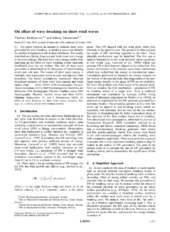| dc.contributor.author | Kudryavtsev, Vladimir | eng |
| dc.contributor.author | Johannessen, Johnny A. | eng |
| dc.date.accessioned | 2006-01-11T11:38:36Z | |
| dc.date.available | 2006-01-11T11:38:36Z | |
| dc.date.issued | 2004-10 | eng |
| dc.Published | Geophysical Research Letters 31(20): L20310 | en |
| dc.identifier.issn | 0094-8276 | en_US |
| dc.identifier.uri | https://hdl.handle.net/1956/865 | |
| dc.description.abstract | The paper presents an attempt to estimate short wave generation by wave breaking. A breaking wave crest disturbs the surface and generates sub-surface turbulence. The locally disturbed area further disperses and feeds short wave energy to the surroundings. The total short wave energy results from summing up the effect of wave breaking events randomly distributed over the sea surface. The rate of short wave generation is determined by the frequency of wavebreaking events per unit area. The source of short wave energy is isotropic, thus it generates waves at cross and opposite wind directions. The model qualitatively reproduces observed directional property of short wind wave spectra and mean square slope. | en_US |
| dc.format.extent | 125073 bytes | eng |
| dc.format.mimetype | application/pdf | eng |
| dc.language.iso | eng | eng |
| dc.publisher | American Geophysical Union | en_US |
| dc.subject | Oceanography | eng |
| dc.title | On effect of wave breaking on short wind waves | en_US |
| dc.type | Peer reviewed | |
| dc.type | Journal article | |
| dc.description.version | publishedVersion | en_US |
| dc.rights.holder | Copyright 2004 by the American Geophysical Union | en_US |
| dc.identifier.doi | https://doi.org/10.1029/2004gl020619 | |
| dc.source.journal | Geophysical Research Letters | |
| dc.source.40 | 31 | |
| dc.source.14 | 20 | |
